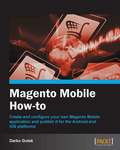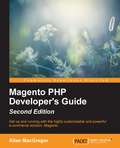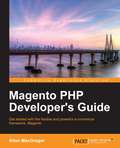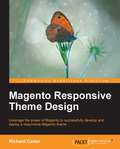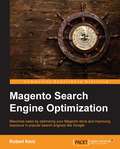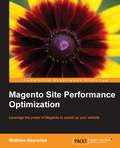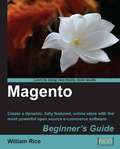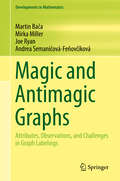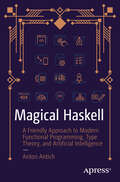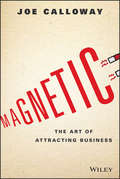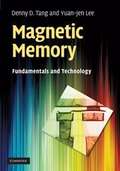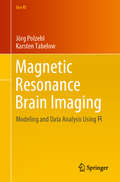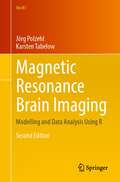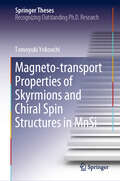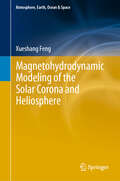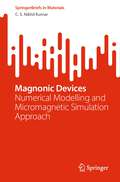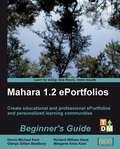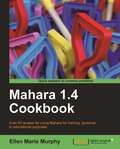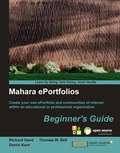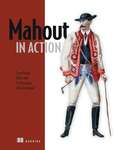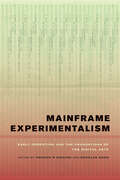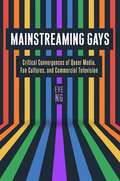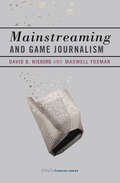- Table View
- List View
Magento Mobile How-to
by Darko GolesFollow the creation of a sample Magento Mobile application with plenty of screenshots and practical examples to guide you along the way. This book is great for Magento store owners and administrators that want to expand their business to mobile platforms with minimal investment. Also this is an irreplaceable manual for Magento developers when configuring Magento Mobile applications for clients.
Magento PHP Developer's Guide - Second Edition
by Allan MacgregorThis book is written for PHP developers who are familiar with frameworks such as Zend or CakePHP and want to start developing and working with Magento. No prior knowledge of Magento is required.
Magento PHP Developer’s Guide
by Allan MacgregorMagento PHP Developer's Guide is an easily accessible tutorial, designed and written to give the reader maximum understanding of the powerful Magento framework. This book is written for developers who have previous experience with PHP and PHP frameworks, such as Zend or CakePHP, and want to start developing and working with Magento. Even developers with previous experience with Magento will find the book extremely useful to gain a full understanding of Magento fundamentals, architecture, and overall philosophy.
Magento Responsive Theme Design
by Richard CarterThe book consists of a complete step-by-step tutorial that takes you through how to quickly and efficiently build your own responsive Magento theme.This book is for web designers and developers with an existing knowledge of modern HTML and CSS.
Magento Search Engine Optimization
by Robert KentThis book is an easy-to-follow tutorial with best practices and advanced references which will help you to take full advantage of Magento with SEO. This book is aimed at both Magento developers and SEO specialists who wish to optimize search and end user elements such as click-through rates to ensure the design of their online shop sites effectively maximize sales. Magento store owners may also find large sections of this book useful in order to understand the larger impact small tweaks and changes can have on SEO - especially when editing products and categories. This book assumes that the reader will understand the basic concepts of keyword research and the external factors that are required in order to manage an on-going SEO campaign.
Magento Site Performance Optimization
by Mathieu NayrollesMagento Site Performance Optimization follows a handson, easytofollow approach, which focuses on the optimization of Magento's performance. Each chapter has a very logical flow, which makes the book readerfriendly. This book is written for Magento administrators who wish to optimize their store to increase performance, without spending thousands of dollars a year for the enterprise edition of Magento. It is noteworthy that Magento, as a project, comes with a gigantic code base and tools; however, the reader needs to be up for the challenge, ready to produce their own code to make the most of its code base.
Magento: Beginner's Guide
by William RiceThis book will provide you with step-by-step instructions for installing, configuring, and using Magento to run your own e-commerce site. We will set up an example store in the book with enough information to adapt the instructions according to your needs.This book is for anyone who wants to create an online store using Magento. If you are a non-technical person and are discouraged by the complexity of this powerful e-commerce application, this book is ideal for you.
Magic and Antimagic Graphs: Attributes, Observations and Challenges in Graph Labelings (Developments in Mathematics #60)
by Mirka Miller Joe Ryan Martin Bača Andrea Semaničová-FeňovčíkováMagic and antimagic labelings are among the oldest labeling schemes in graph theory. This book takes readers on a journey through these labelings, from early beginnings with magic squares up to the latest results and beyond.Starting from the very basics, the book offers a detailed account of all magic and antimagic type labelings of undirected graphs. Long-standing problems are surveyed and presented along with recent results in classical labelings. In addition, the book covers an assortment of variations on the labeling theme, all in one self-contained monograph.Assuming only basic familiarity with graphs, this book, complete with carefully written proofs of most results, is an ideal introduction to graph labeling for students learning the subject. More than 150 open problems and conjectures make it an invaluable guide for postgraduate and early career researchers, as well as an excellent reference for established graph theorists.
Magical Haskell: A Friendly Approach to Modern Functional Programming, Type Theory, and Artificial Intelligence
by Anton AntichDiscover a unique and fun approach to adopting modern typed functions programming patterns. This book uses playful metaphors and examples to help you learn Haskell through imagination, building on math without relying on imperative crutches or technical complexity. You’ll use math to build completely different Typed Functional patterns from the ground up and understand the link between building Mathematics through Types and constructing Haskell as a programming language. Intended for working with various applications, especially AI-powered apps, the book gently builds up to what are normally considered complex and difficult concepts all without needing a PhD to understand them. Illustrative explanations will guide you to tackle monads, using monad transformer stacks to structure real programs, foldable and traversable structures, as well as other Type classes. This book will also help you structure programs efficiently and apply your own abstractions to real-life problem domains. Next, you’ll explore exciting advancements in AI, including building with OpenAI APIs, creating a terminal chatbot, adding web functionality, and enhancing with retrieval-augmented generation. Finally, you’ll delve into AI multi-agents and future directions using Arrows abstraction, reinforcing Haskell’s design. Magical Haskell is a solution for programmers who feel limited by imperative programming languages but are also put off by excessively mathematical approaches. What You Will Learn Grasp a solid math foundation without complex technicalities for Types and Typeclasses. Solve problems via a typed functional approach and understand why it’s superior to what’s available in the imperative language world (“if it compiles, it runs”). Build your own abstractions to efficiently resolve problems in any given domain. Develop AI frameworks in Haskell, including chatbots, web functionality, and retrieval-augmented generation. Who This Book Is For Haskell programmers of all levels and those interested in Type Theory.
Magnetic
by Joe CallowayMagnetic: The Art of Attracting Business is a look at how consistently successful businesses are able to attract a steady and ever-increasing flow of customers. This innovative text examines a range of simple, powerful strategies that businesses of any size or type can use to attract new customers. The key is to do those things that harness the power of the single most important factor in buying decisions: positive word of mouth and referrals from happy existing customers. Magnetic businesses are intentional, strategic, and focused on creating positive experiences that become the stories their customers tell about them. Whether on the internet or face to face, it's what satisfied customers say about you that is the most powerful driver of growth for your business. Becoming Magnetic and attracting business, truly is an art, rather than a science, because every business is different, and uses a unique combination of strategy, people, and purpose to achieve success and growth. There is no one-size-fits-all formula, but with creativity and focus, any business can create a powerful revenue growth engine that continuously works to build and sustain success. Learn how to match successful growth strategies with your people, purpose, and culture to create your own unique 'magnetism' to attract business. Discover the simple, powerful keys to growth used by a range of market leading businesses, from a snowboard manufacturing startup company and a website design professional to a minor league baseball team and an family owned upscale grocery store. All of them utilize ideas that you can put to work immediately in your business to become Magnetic. Create a magnetic mindset in your people that leads not only to happier customers who refer others to you, but to more satisfied employees who help attract and recruit great new employees to keep your momentum going. Simplify and clarify how you think about your business to have your entire team become more focused, efficient, and effective in doing those few vitally important things that matters most in driving growth and sustaining success.
Magnetic Dynamics in Antiferromagnetically-Coupled Ferrimagnets: The Role of Angular Momentum (Springer Theses)
by Takaya OkunoThis book presents the theoretical and experimental investigations on antiferromagnetically coupled ferrimagnets and reveals new aspects of ferrimagnetic dynamics in terms of the role of angular momentum. The purpose of this book is to show readers that antiferromagnets/ferrimagnets are useful in spintronic devices in that (1) The nonadiabatic spintransfer torque in antiferromagnets acts as a staggered magnetic field, which can drive the magnetic domain walls, and (2) The Gilbert damping parameter α, the energy dissipation rate associated with the magnetic dynamics of ferrimagnets, is insensitive to temperature in contrast to the conventional understanding that the effective α of ferrimagnets diverges at the angular momentum compensation temperature. This book provides readers with a scientific platform of ferrimagnetic dynamics, which serves as a useful basis for realizing the next generation of spintronic devices.
Magnetic Memory
by Denny D. Tang Yuan-Jen LeeIf you are a semiconductor engineer or a magnetics physicist developing magnetic memory, get the information you need with this, the first book on magnetic memory. From magnetics to the engineering design of memory, this practical book explains key magnetic properties and how they are related to memory performance, characterization methods of magnetic films, and tunneling magnetoresistance effect devices. It also covers memory cell options, array architecture, circuit models, and read-write engineering issues. You'll understand the soft fail nature of magnetic memory, which is very different from that of semiconductor memory, as well as methods to deal with the issue. You'll also get invaluable problem-solving insights from real-world memory case studies. This is an essential book for semiconductor engineers who need to understand magnetics, and for magnetics physicists who work with MRAM. It is also a valuable reference for graduate students working in electronic/magnetic device research.
Magnetic Resonance Brain Imaging: Modeling and Data Analysis Using R (Use R!)
by Jörg Polzehl Karsten TabelowThis book discusses the modeling and analysis of magnetic resonance imaging (MRI) data acquired from the human brain. The data processing pipelines described rely on R. The book is intended for readers from two communities: Statisticians who are interested in neuroimaging and looking for an introduction to the acquired data and typical scientific problems in the field; and neuroimaging students wanting to learn about the statistical modeling and analysis of MRI data. Offering a practical introduction to the field, the book focuses on those problems in data analysis for which implementations within R are available. It also includes fully worked examples and as such serves as a tutorial on MRI analysis with R, from which the readers can derive their own data processing scripts. The book starts with a short introduction to MRI and then examines the process of reading and writing common neuroimaging data formats to and from the R session. The main chapters cover three common MR imaging modalities and their data modeling and analysis problems: functional MRI, diffusion MRI, and Multi-Parameter Mapping. The book concludes with extended appendices providing details of the non-parametric statistics used and the resources for R and MRI data.The book also addresses the issues of reproducibility and topics like data organization and description, as well as open data and open science. It relies solely on a dynamic report generation with knitr and uses neuroimaging data publicly available in data repositories. The PDF was created executing the R code in the chunks and then running LaTeX, which means that almost all figures, numbers, and results were generated while producing the PDF from the sources.
Magnetic Resonance Brain Imaging: Modelling and Data Analysis Using R (Use R!)
by Jörg Polzehl Karsten TabelowThis book discusses modelling and analysis of Magnetic Resonance Imaging (MRI) data of the human brain. For the data processing pipelines we rely on R, the software environment for statistical computing and graphics. The book is intended for readers from two communities: Statisticians, who are interested in neuroimaging and look for an introduction to the acquired data and typical scientific problems in the field and neuroimaging students, who want to learn about the statistical modeling and analysis of MRI data. Being a practical introduction, the book focuses on those problems in data analysis for which implementations within R are available. By providing full worked-out examples the book thus serves as a tutorial for MRI analysis with R, from which the reader can derive its own data processing scripts.The book starts with a short introduction into MRI. The next chapter considers the process of reading and writing common neuroimaging data formats to and from the R session. The main chapters then cover four common MR imaging modalities and their data modeling and analysis problems: functional MRI, diffusion MRI, Multi-Parameter Mapping and Inversion Recovery MRI. The book concludes with extended Appendices on details of the utilize non-parametric statistics and on resources for R and MRI data.The book also addresses the issues of reproducibility and topics like data organization and description, open data and open science. It completely relies on a dynamic report generation with knitr: The books R-code and intermediate results are available for reproducibility of the examples.
Magnetic Straintronics: An Energy-Efficient Hardware Paradigm for Digital and Analog Information Processing (Synthesis Lectures on Engineering, Science, and Technology)
by Supriyo BandyopadhyayThis book covers the new field of straintronics, using strain switched nanomagnets for extremely energy-efficient computing, information processing, communication, and signal generation. Based on well-established CMOS technology, traditional electronics have two significant shortcomings: excessive energy dissipation and volatility, which is the inability to retain information after power has been switched off. Straintronics is more energy-efficient and non-volatile (but also more error-prone), allowing it to eclipse traditional electronics in niche areas that are increasingly attracting attention, such as image processing and probabilistic computing, computer vision, machine learning, neuromorphic networks, probabilistic computing, and belief networks. Magnetic Straintronics: An Energy-Efficient Hardware Paradigm for Digital and Analog Information Processing introduces straintronics and the technology's myriad applications for researchers, engineers, and scientists in electrical engineering, physics, and computer engineering.
Magneto-transport Properties of Skyrmions and Chiral Spin Structures in MnSi (Springer Theses)
by Tomoyuki YokouchiThis book provides extensive and novel insights into transport phenomena in MnSi, paving the way for applying the topology and chirality of spin textures to the development of spintronics devices. In particular, it describes in detail the key measurements, e.g. magnetoresistance and nonlinear electronic transport, and multiple material-fabrication techniques based on molecular beam epitaxy, ion-beam microfabrication and micromagnetic simulation. The book also reviews key aspects of B20-type MnSi chiral magnets, which host magnetic skyrmions, nanoscale objects formed by helical spatial spin structures. Readers are then introduced to cutting-edge findings on the material. Furthermore, by reviewing the author’s successful experiments, the book provides readers with a valuable update on the latest achievements in the measurement and fabrication of magnetic materials in spintronics.
Magnetohydrodynamic Modeling of the Solar Corona and Heliosphere (Atmosphere, Earth, Ocean & Space)
by Xueshang FengThe book covers intimately all the topics necessary for the development of a robust magnetohydrodynamic (MHD) code within the framework of the cell-centered finite volume method (FVM) and its applications in space weather study. First, it presents a brief review of existing MHD models in studying solar corona and the heliosphere. Then it introduces the cell-centered FVM in three-dimensional computational domain. Finally, the book presents some applications of FVM to the MHD codes on spherical coordinates in various research fields of space weather, focusing on the development of the 3D Solar-InterPlanetary space-time Conservation Element and Solution Element (SIP-CESE) MHD model and its applications to space weather studies in various aspects. The book is written for senior undergraduates, graduate students, lecturers, engineers and researchers in solar-terrestrial physics, space weather theory, modeling, and prediction, computational fluid dynamics, and MHD simulations. It helps readers to fully understand and implement a robust and versatile MHD code based on the cell-centered FVM.
Magnonic Devices: Numerical Modelling and Micromagnetic Simulation Approach (SpringerBriefs in Materials)
by C. S. Nikhil KumarThis book briefly looks at numerical modeling and micromagnetic simulation results of magnonic crystals, which are periodically modulated magnonic devices regarded as the magnetic counterpart of photonic crystals with spin waves acting as the information carrier. Since the wavelength of the spin wave is several orders of magnitude shorter than that of electromagnetic waves of the same frequency, magnonic crystals are promising candidates for miniaturization, especially in the fields of data storage and processing. The book begins by describing the dispersion relation of dipolar spin waves in a magnonic curved waveguide, solving Walker's equation in cylindrical coordinates, and then calculating the dispersion of exchange spin waves using perturbation theory. It describes simulated nano-contact-driven spin wave excitations in a magnonic cavity, featuring a design of an antidot magnonic crystal around the nano-contact, with the frequency of the spin wave mode generated lying within the band gap of the magnonic crystal. The proposed device behaves as a SWASER—Spin Wave Amplification by the Stimulated Emission of Radiation. This book will find interest among researchers and practitioners interested in the modeling, simulation, and design of novel magnonic devices.
Mahara 1.2 E-Portfolios: Beginner's Guide
by Glenys Gillian Bradbury Derrin Michael KentThis book will provide you with step-by-step instructions to get started with Mahara and create an impressive electronic portfolio. The book is packed with many useful examples and screenshots for easy and quick learning. Pick this book up if you want to get started with Mahara. This book is for you if: You are a student/learner wanting to maintain online documentation of your projects and share it with a particular teacher/trainer for feedback, You are a teacher wanting to set up an e-portfolio for your students in order to encourage and advance personalized and reflective learning, You are a professional wanting to share your journals and project documents with your team by sharing your existing knowledge and creating new knowledge in communities of professional practice, No previous experience of Mahara is required.
Mahara 1.4 Cookbook
by Ellen Marie MurphyPart of Packt's cookbook series, this book offers learning and techniques through recipes. It contains step-by-step instructions for Mahara users of all kinds. It is designed in such a way that you can refer to recipes chapter by chapter, or read them in no particular order. Whether you are a student, an instructor, an administrator, or simply someone who would like to build your own portfolio, this book is for you. The range of recipes is wide, because Mahara's features can support portfolio development and use, regardless of level or purpose. This book requires only a very basic knowledge of Mahara.
Mahara ePortfolios: Beginner’s Guide
by Derrin KentThis book will provide you with step-by-step instructions to get started with Mahara and create an impressive electronic portfolio. The book is packed with many useful examples and screenshots for easy and quick learning. Pick up this book if you want to get started with Mahara. This book is for you if: You are an employee, student or other type of learner wanting to maintain online documentation of your projects and share it with a particular assessor/CPD Manager/teacher/trainer for feedback. You are a teacher or mentor wanting to set up an e-portfolio for your students or employees in order to encourage and advance personalized and reflective learning. You are a professional wanting to share your journals and project documents with your team by sharing your existing knowledge and creating new knowledge in communities of professional practice. You are a human resources professional who wants a software application which will enable your team to generate, capture and transfer tacit knowledge. No previous experience of Mahara is required
Mahout in Action
by Ted Dunning Sean Owen B. Ellen Friedman Robin AnilSummaryMahout in Action is a hands-on introduction to machine learning with Apache Mahout. Following real-world examples, the book presents practical use cases and then illustrates how Mahout can be applied to solve them. Includes a free audio- and video-enhanced ebook.About the TechnologyA computer system that learns and adapts as it collects data can be really powerful. Mahout, Apache's open source machine learning project, captures the core algorithms of recommendation systems, classification, and clustering in ready-to-use, scalable libraries. With Mahout, you can immediately apply to your own projects the machine learning techniques that drive Amazon, Netflix, and others.About this BookThis book covers machine learning using Apache Mahout. Based on experience with real-world applications, it introduces practical use cases and illustrates how Mahout can be applied to solve them. It places particular focus on issues of scalability and how to apply these techniques against large data sets using the Apache Hadoop framework.This book is written for developers familiar with Java -- no prior experience with Mahout is assumed.Owners of a Manning pBook purchased anywhere in the world can download a free eBook from manning.com at any time. They can do so multiple times and in any or all formats available (PDF, ePub or Kindle). To do so, customers must register their printed copy on Manning's site by creating a user account and then following instructions printed on the pBook registration insert at the front of the book.What's InsideUse group data to make individual recommendationsFind logical clusters within your dataFilter and refine with on-the-fly classificationFree audio and video extrasTable of ContentsMeet Apache MahoutPART 1 RECOMMENDATIONSIntroducing recommendersRepresenting recommender dataMaking recommendationsTaking recommenders to productionDistributing recommendation computationsPART 2 CLUSTERINGIntroduction to clusteringRepresenting dataClustering algorithms in MahoutEvaluating and improving clustering qualityTaking clustering to productionReal-world applications of clusteringPART 3 CLASSIFICATIONIntroduction to classificationTraining a classifier Evaluating and tuning a classifierDeploying a classifierCase study: Shop It To Me
Mainframe Experimentalism: Early Computing and the Foundations of the Digital Arts
by Douglas Kahn Hannah B. HigginsMainframe Experimentalism challenges the conventional wisdom that the digital arts arose out of Silicon Valley’s technological revolutions in the 1970s. In fact, in the 1960s, a diverse array of artists, musicians, poets, writers, and filmmakers around the world were engaging with mainframe and mini-computers to create innovative new artworks that contradict the stereotypes of "computer art." Juxtaposing the original works alongside scholarly contributions by well-established and emerging scholars from several disciplines, Mainframe Experimentalism demonstrates that the radical and experimental aesthetics and political and cultural engagements of early digital art stand as precursors for the mobility among technological platforms, artistic forms, and social sites that has become commonplace today.
Mainstreaming Gays: Critical Convergences of Queer Media, Fan Cultures, and Commercial Television
by Eve NgMainstreaming Gays discusses a key transitional period linking the eras of legacy and streaming, analyzing how queer production and interaction that had earlier occurred outside the mainstream was transformed by multiple converging trends: the emergence of digital media, the rising influence of fan cultures, and increasing interest in LGBTQ content within commercial media. The U.S. networks Bravo and Logo broke new ground in the early 2000s and 2010s with their channel programming, as well as bringing in a new cohort of LGBTQ digital content creators, providing unprecedented opportunities for independent queer producers, and hosting distinctive spaces for queer interaction online centered on pop culture and politics rather than dating. These developments constituted the ground from which recent developments for LGBTQ content and queer sociality online have emerged. Mainstreaming Gays is critical reading for those interested in media production, fandom, subcultures, and LGBTQ digital media.
Mainstreaming and Game Journalism (Playful Thinking)
by David B. Nieborg Maxwell FoxmanWhy games are still niche and not mainstream, and how journalism can help them gain cultural credibility.Mainstreaming and Game Journalism addresses both the history and current practice of game journalism, along with the roles writers and industry play in conveying that the medium is a &“mainstream&” form of entertainment. Through interviews with reporters, David B. Nieborg and Maxwell Foxman retrace how the game industry and journalists started a subcultural spiral in the 1980s that continues to this day. Digital play became increasingly exclusionary by appealing to niche audiences, relying on hardcore fans and favoring the male gamer stereotype. At the same time, this culture pushed journalists to the margins, leaving them toiling to find freelance gigs and deeply ambivalent about their profession.Mainstreaming and Game Journalism also examines the bumpy process of what we think of as &“mainstreaming.&” The authors argue that it encompasses three overlapping factors. First, for games to become mainstream, they need to become more ubiquitous through broader media coverage. Second, an increase in ludic literacy, or how-to play games, determines whether that greater visibility translates into accessibility. Third, the mainstreaming of games must gain cultural legitimacy. The fact that games are more visible does little if only a few people take them seriously or deem them worthy of attention. Ultimately, Mainstreaming and Game Journalism provocatively questions whether games ever will—or even should—gain widespread cultural acceptance.
